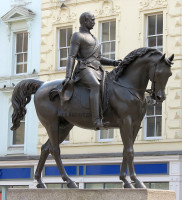
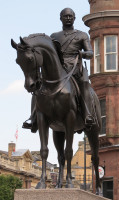
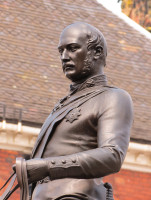
Views of the Wolverhampton Prince Albert statue.
Views of the Wolverhampton Prince Albert statue.


Queen Square has one grand statue, the equestrian Prince Albert, and two works of architectural sculpture on two large bank buildings.
The equestrian statue of Prince Albert is the centrepiece of the Square. The statue, by Thomas Thornycroft, is a noble monument to the great patron of the arts and husband of Queen Victoria. He sits erect, reins in one hand, the horse with an emphasis on the curved neck and out-thrust tail, filled with nervous energy and a contrast to the calm rider. It was Thornycroft’s second equestrian statue of Prince Albert, dating from 1866, a couple of years after the one he made for Halifax; a third one was to follow in 1868 for Liverpool (see this page), along with a Queen Victoria a couple of years later. There are not such a large number of equestrian statues across the country, and Wolverhampton is lucky to have this one.
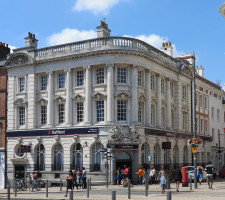
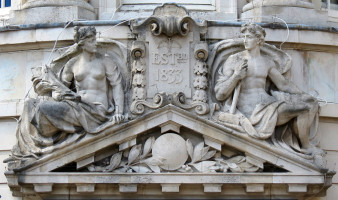 Nat West building with pair of statues.
Nat West building with pair of statues.
A prominent building on the Square is the Nat West Bank building, an Edwardian effort of three storeys, with giant attached pillars (Ionic) from the first floor to the top of the second, a balustrade on top, and rounded pediments and the tops of the windows in a mild Baroque, rather restrained by Edwardian standards. Buildings like this are found across the country; in London, parts of Whitehall and much of Kingsway were built in this fashion. Although clearly Edwardian in style, the building was not completed until after World War I – not unusual. Bromley and Watkins were the architects, and it was built for the then National Provincial Bank. From the perspective of these pages, the most interest is in the main corner entrance, above which is a pediment with a pair of figures sculpted in Portland stone, male and female, seated upon it. Were they standing instead of reclining, they would be a little over lifesize height. Between them is a shield of arms. The male statue is of the Grecian type, nude except for a single drape across and behind his legs, and then swirling up behind him as if a cloak. He is slenderly muscular, an athlete rather than a strongman, and his pose is easy and relaxed. He represents Industry, carrying a mallet in one hand, and behind his legs is a beehive, symbol of industrious activity. (More allegorical figures of Industry on this page). The female statue has a crown of laurel leaves in her hair, and wears a full skirt of drapes, but her upper torso and arms are bare, revealing a muscularity matching that of the male figure. She is Agriculture, most particularly with its connotations of fruitfulness (hence her bare, full breasts), and carries a sheaf of corn; the ripened ears of corn, the product of toil and time, are appropriate for a bank where a person’s money, fruit of their toil, can be likewise left so that in time, an increase can be harvested. For other statues of Agriculture, see this page. The central shield, a squarish thing with scrolls top and bottom and oak leaves and acorns to the side (symbolic of permanency), has the logo of a winged Caduceus (snakes wound round a staff) and the words’ Est[abolished] 1833. The Caduceus is here used as an attribute of Mercury, and refers to trade - other examples and uses of the Caduceus are on the snake page on this site. The small pediment on which the pair of figures are seated bears a disk and an olive branch.
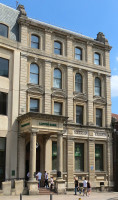 Lloyds Bank, architect J. A. Chatwin.
Lloyds Bank, architect J. A. Chatwin.
The Italianate Lloyds building just off the Square in Dudley Street, by the architect J. A. Chatwin and put up in 1878, bears three short friezes at first floor level sculpted with many small figures. From the left, the first panel shows ore, and pickaxes and transport by coal train. Next an agricultural scene, with peasants in a field, with the central groupings shown handling the tied sheaves of corn, and piling them onto a wagon, while the right-most panel is back to industry, with factory workers operating a variety of machinery, including a furnace and a heavy press. The scale of the work means that the individual figures are small and limited in detailing. However, the poses are well caught and the figure groupings done with much thought, giving a pleasing flow to the activities. The sculptural work was carried out by Boulton’s of Cheltenham, as for their friezes on the Art Gallery up the road (see the page on St Peter's Gardens).
Boulton's sculptural friezes of agriculture and industry.


There are two other buildings off the Square we should note. On the slope downwards to the south west, at the corner of Victoria Street and Darlington Street, is the Beatties building, 1930s with nice detailing – notice especially the iconic 1930s clock in front of the building, and the elephant head tops to the pilasters. In fact the corner was not originally Beatties, which had the buildings on each side (architects Lavender, Twentyman and Percy), but a branch of Burtons, the men’s clothing store, and the art deco motifs are similar to other buildings of theirs elsewhere.
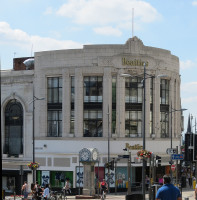
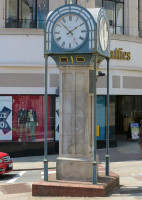 Beatties, 1930s, and deco clock.
Beatties, 1930s, and deco clock.
And a look down North Street, coming off the Square, reveals the Old Town Hall, with a long, rather low and rather flat frontage which looks best at a sharp angle, when the French mansard roofs and ironwork and pinnacles thereon can be appreciated. E, Bates was the architect, and the building dates from 1869-71. Alas, the sculptural adornment is limited to the capitals of the pillars (Corinthian), reliefs of stylised flowers, a coat of arms, and the pots on the top of the building, all of which except the pots are rather lost on the scale of the building: an accent rather than a proper decoration.
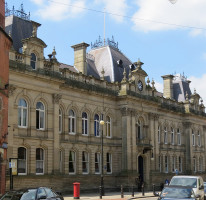
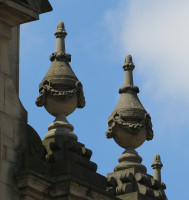 The Old Town Hall, North Street.
The Old Town Hall, North Street.
Introduction to Wolverhampton sculpture // Sculpture in St Peter's Gardens nearby // and in St Peter's Church itself
Birmingham sculpture // Sculpture in some other places in England
Thomas Thornycroft // Other Sculptors
Visits to this page from 18 Aug 2014: 13,194